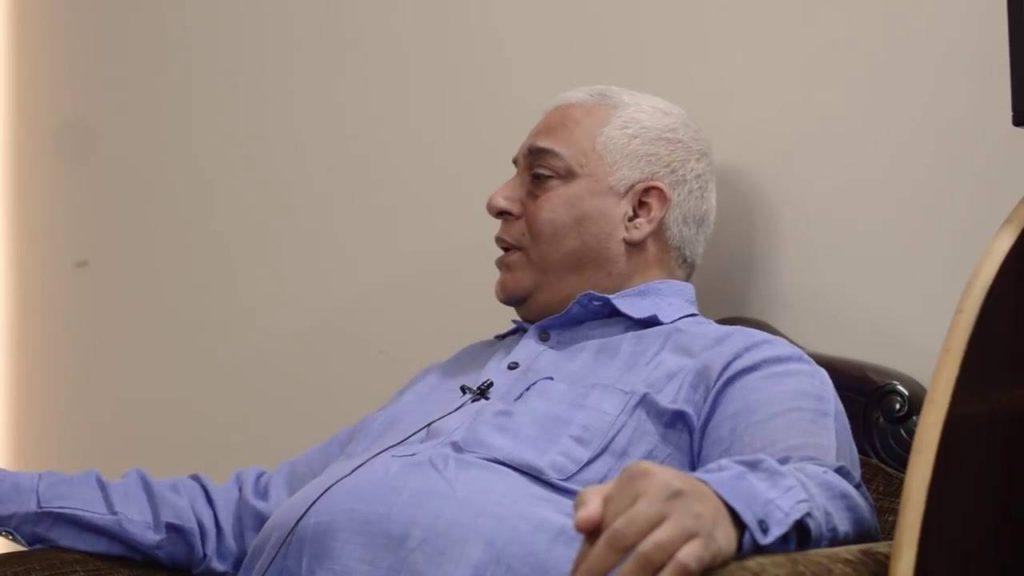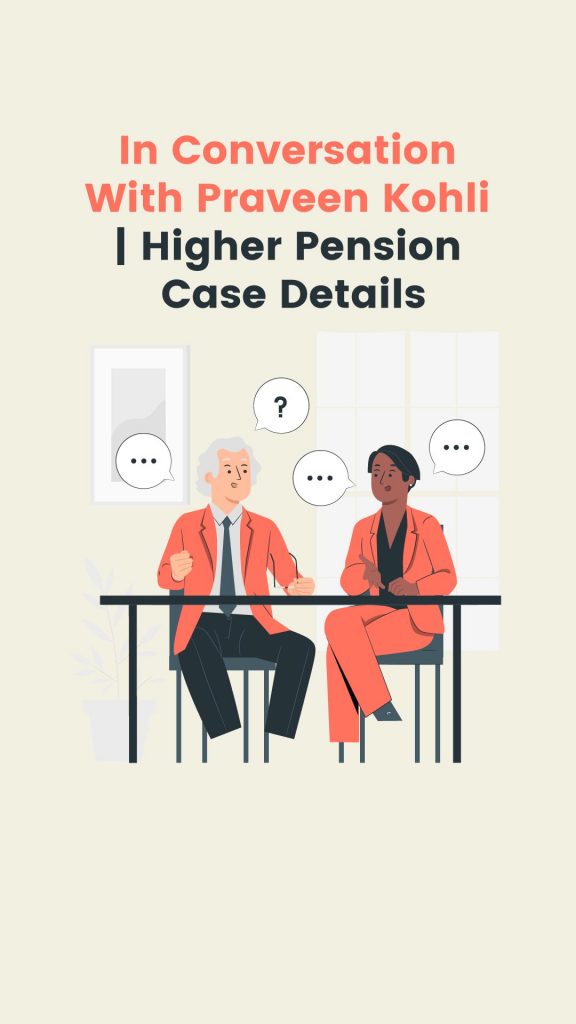Mr Praveen Kohli is well-known for his eminent higher pension case. He was successful in increasing his pension by a magnanimous 1200%. Not only this, but he has also been helping many other pensioners get a higher pension through the Employee Pension Scheme Act 1995. We had the amazing opportunity to interview this personality. Read on for excerpts from our interview.

Table of Contents
Excerpts from interview with Mr Praveen Kohli on higher pension
Q: Was your case the first one ever regarding a higher pension scheme or have there been similar cases before?
Praveen Kohli: “There were other cases like this before mine and the base of this case was a provision added in the Employee Pension Scheme in 1996. Through some provision made by a GSR, the people who want to get a pension on their full salaries, need to contribute their full salary with the consent of both the employee and employer. In order to get the full salary share from their employer under the 8.33% Employee Pension Scheme 1995. Normally 8.33% comes under the sealing amount. But most people were unaware of this provision because the government did not publicize it. To be very frank, I too was unaware of this provision in the scheme.
Later, 8 court cases were filed from Kerala and Himachal Pradesh which ultimately reached the Supreme Court. The Supreme Court signified the cases from Kerala as okay after 9 years, i.e in 2016. Supreme Court said that they don’t want to interfere with decision taken on Kerala cases. It allowed the employees to pay the differential amount along with the interest in order to avail the higher pension. Thus, the employees could get pension on their full salary.
But, regarding the case of Himachal Pradesh which ultimately came into action on 4th Oct 2016, the Supreme Court elaborated to some extent. The Supreme Court said that the imposition of a cutoff date is wrong and should be done away with. Thus, the CBT decided to extend the benefit to all. During that period there was no issue regarding exempted trust employees. Neither was there an issue in any of the court cases. After that on 23rd March, the EPFO released an official letter to make this provision in the pension scheme available to all regardless if they had filed a court case for it or not. This announcement was also made by then Labour Minister.”
Q: What was your pension before the Supreme Court decision and what is it currently?
Praveen Kohli: “My pension was fixed at Rs 2109 which was a wrong calculation. So I have challenged it and fought with the EPFO further. After that, they agreed on this particular fact and revised my pension to Rs 2187. Along with this, they gave me arrears as well. This amount was further revised to Rs 2372 after a period of 2 years. Finally, post the Supreme Court’s decision my pension is Rs 30,592.”
Q: When did you start getting this higher pension benefit?
Praveen Kohli: “I started getting the benefit from 5th November 2013 which was at the age of 58. The EPFO takes the date of one turning 58 years as the pension delivery date.”
Q: Which employees are eligible for a higher pension?
Praveen Kohli: “Those who contributed to their ceiling wages, are not eligible for this benefit. There are about 78% of people who are currently not eligible. Furthermore, 22% of people contributing to actual wages are eligible for it. Under Clause 26.6 of the Pension Scheme, both the employer and employee have to submit a joint declaration. Both have to agree to pay contribution on the full salary in this joint declaration. The employer also has to agree to pay admin charges on the actual salary. Hence, the EPFO agrees to the condition. I received this permission in 1989.”
Q: What is the process of applying for a higher pension?
Praveen Kohli: “Those employees who retired before 1st Sept 2014, can obtain the joint declaration form available at the EPFO. The government did not standardize that form. Although I had written to the government at that time that the whole country needs this particular form. I told them that they should standardize the form and put it on their website so that no one faces a problem in the future. I wrote to the labour sector also. But, that did not happen.
Basically, an employee needs to fill up the joint declaration form and send it to their employer. The authorized signatory of the employer has to sign on the form. Along with that, the Form 3A is to be attached by the employer. Factually, the EPFO already has the Form 3A for all employees but asks for them again nonetheless. Additionally, salary proof of the last 12 months has to be given. These documents have to be submitted to the PF department via the employer.
Once the EPFO lost the 2013 higher pension case in Kerala, they released a gazette notification 609 on 22nd August 2014. According to the notification, employees joining after 1st September 2014 with a salary of over Rs 15,000 could not become members of EPF/EPS. Furthermore, eligible employees had to give a fresh agreement within six months of 1st September 2014 to ask for pension on the full salary. This cutoff date was further extended on a discretionary basis for six more months. But hardly some people got to know about this notification so very few applied for it. Employees asking for higher pension also have to pay on wages above Rs 15,000 instead of the government paying for it. This was against the scheme.”
Q: The minimum pension was increased to Rs 1000, then why are some people still getting Rs 600-700 as a pension?
Praveen Kohli: “This is happening for those people who opted for ROC (Return on Captial) and got their pension commuted. There was a provision in the scheme for death post-retirement where they will get their money back. The other aspect was the computation. In this, wages for 100 months are given as advance by 1.3%. So, the ones who have earlier applied for this are receiving the above-mentioned amount as pension today. Others are allowed to have the Rs 1000, set by the department.
However, EPFO has ceased to offer this commutation and ROC facility from 2008. There will be no commutation or return of capital. Even under the commutation category by the government, there were a lot of issues. As per the scheme, 100 months was a limit to get the returns. But, the amount was not restored even after the completion of 100 months. The commutation went on till the death of the person which is incorrect.”
Q: What is the differential amount and how is it calculated?
Praveen Kohli: “EPFO is liable to calculate the differential amount to be paid and will add the interest too. Further, they will be communicating the employee regarding their differential amount. The amount above the ceiling amount was 1.16% and it is now taken from the employees by the EPFO without any authority. Without GSR, EPFO cannot bring about any changes.
Post 1st September 2014, the department has derived the GSR of all the employees and changed the rule that this 1.16% amount above the ceiling amount will also be paid by the employees. Although this change is challenged by a lot of departments and firms, nothing concrete seems to have taken place.
Moreover, the EPFO started collecting DA from the employees who joined before 1st September 2014 as well. So I filed an RTI and asked for a copy of the order asking for the same. RTI simply denied saying they do not have any such orders. Even the PF Commissioner does not have any information on this aspect. The entire scenario shows that lack of knowledge can be dangerous as people do not have a clear idea about it.”

Q: What is the last resort or employees if they do not get any help from the employer for this?
Praveen Kohli: “There is no such provision where the employees can directly inspect or investigate about their pension and PF at the moment. There are many employees who come up with complaints that employers are no help when it comes to discrepancies with their PF and pension. The truth behind this negligence is the fear of financial liability to the company. Solutions like submitting an affidavit are the only resort.”
Q: How can one get the Joint Declaration Form?
Praveen Kohli: “As a matter of fact, the Joint Declaration Form varies from company to company. This is because the EPFO has not provided any standard form. Even RTI does not have any copy of the form, only the judgement was enclosed by the department.”
Q: As per the 8th June Circular of the EPFO, it was said that 3570 people have gained access to a higher pension. There are several zones who are still waiting to experience the benefits. Is there any effect of this circular?
Praveen Kohli: “Post 8th June, there will be a faster movement for rendering a higher pension. However, the benefit here is only for the unexempted people. There is no relief for exempted employees. Only those employees will get the benefit who have taken permission under Section 26(6), are contributing to complete salary and are unexempted. Hence, 22% of employees can go ahead and enjoy the benefit of a higher pension.”
Q: Special Information for the Exempted Employees
Praveen Kohli: “The provisions of exemption for pension and the provident fund are separate. Do not confuse both of them. Under section 39, only two organisations in India fall under the exempted category of the EPS. They are Tata Motors and Oil India Ltd. The other organisations are exempted for Provident Fund and not Pension. According to the PF department, the PF records are with the trust of the company and hence they do not have any data. However, the entire set up is not in the right shape because the annual returns of the company having Provident Fund Trust also go to the EPFO department. Similar to Form 3, there is another Form 7PS, which the trust companies need to submit. Therefore, the EPFO receives information about these exempted trusts as well.”
Q: Discrimination under different categories
Praveen Kohli: “The second factor is that there is discrimination between the exempted and unexempted conducted by the EPFO. Under the pension scheme, both unexempted and exempted pay the same amount of money. If the payments are the same, then why are the benefits not the same? This is a grave problem in the department. Furthermore, there is discrimination within the exempted category. In today’s date, there are 15,800 employees who have access to a higher pension. Then why not all? As per the 31st March letter, EPFO says it is not possible, and if not, then from where are these 15,800 people getting the pay?
Another point of discrimination is within the same organization. In industries like ITI, Fact, etc., where the employees who went to the court for the appeal got the rise in pension, but the ones who did not go didn’t receive any benefit. In fact, companies should understand that within the same organisation there cannot be two yardsticks. Therefore, the negligence of EPFO is clearly visible after throwing light on these issues. The bottom line is that nearly 25,000 people are receiving the benefit currently, so why not all?
Q: Any further recommendations by Praveen Kohli
Praveen Kohli: “As an employee who is eligible for the PF and pension, make sure that after you provide the details, you follow up on your contributions as well as maturity. Keep yourself updated regarding all the information, amendments, changes and other aspects by the EPFO. Do not indulge in any sort of violent fights with the employer when there are issues. Try to take a subtle route and work it out with your employer.”
Watch our two-part interview with Mr Praveen Kohli regarding his higher pension case below.
Mr Praveen Kohli has much in-depth knowledge regarding higher pension cases and has a Facebook page called the EPS 95 SEWA Group. Follow this page to know more about the new changes, new amendments, even his RTI actions and repercussions. It is a very useful group for pensioners to get a clear idea of what is going on regarding the ‘95 pension policies and schemes.
Some more PF related engaging and important content for you:
EPF KYC Update Online & Verification Process Explained
Register Employees on EPF in 2 minutes
FAQs About EPF Registration
5 Rules for Easy EPF Calculation
Join the LLA telegram group for frequent updates and documents. Download the telegram group and search ‘Labour Law Advisor’ or follow the link – t.me/JoinLLA
It’s FREE!



